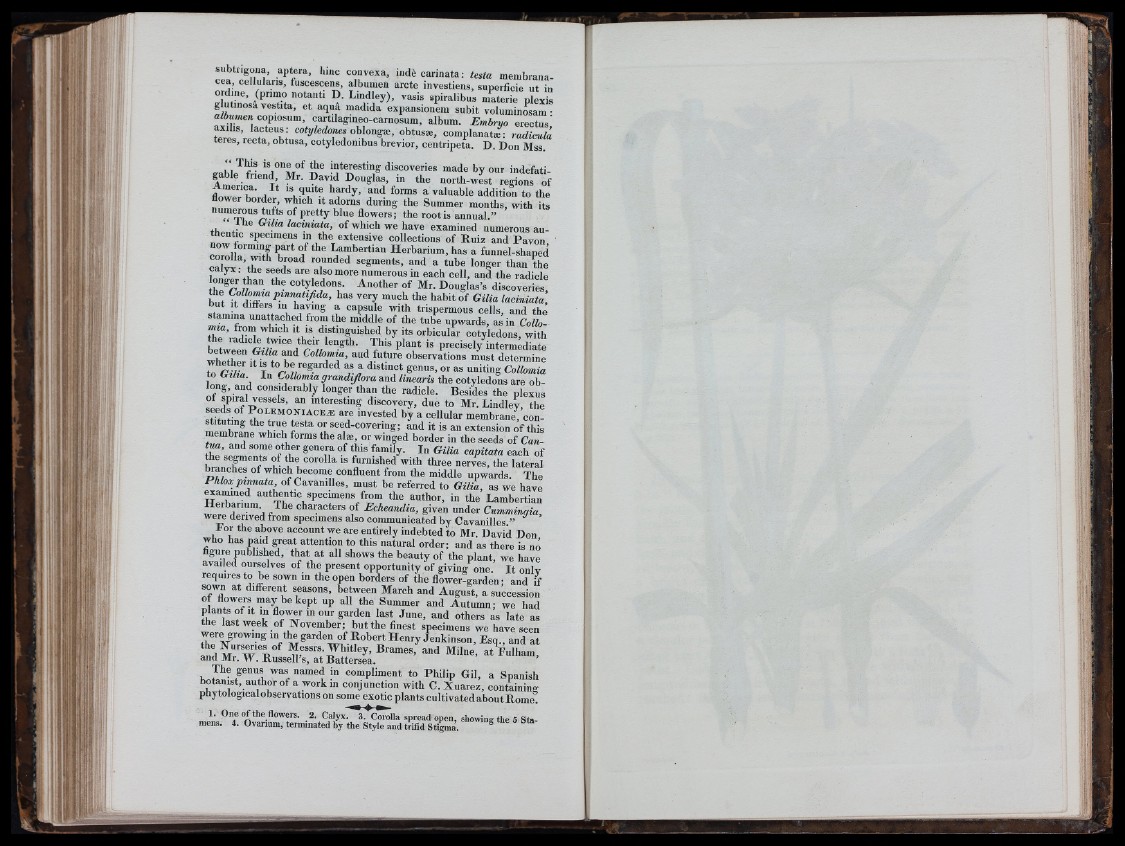
ÍU,
subtngona, aptera, hinc convexa, iiidè carinata; testa menibrana-
cea, cellularis, fuscescens, albumen arete investiens, superficie ut in
oïdine, (primo notanti D. Lindley), vasis spiralibus materie plexis
glutinosa vestita, et aquâ madida expansionen! subit volumin^kam •
atóameii copiosum, cartilagmeo-carnosum, album. E m hm erectus'
axihs, lacteus: coiyZedones oblongæ, obtusæ, complanatæ: radicuù
teres, recta, obtusa, cotyledonibus brevior, centrípeta. D. Don Mss.
“ This is one of the interesting discoveries made by our indefati-
Tt north-west regions of
few L ■ A f y* valuable addition to the
flower border, which it adorns during the Summer months, with its
numerous tufts of pretty blue flowers! the root is annual.”
th p n / ladniata, of which we have examined numerous authentic
specimens in the extensive collections of Ruiz and Pavon
c Z l i r wbh *h fl Lambertian Herbarium, has a funnel-shaped
c a te i r fl segments, and a tube longer than the
calyx, tae seeds are also more numerous in each cell, and the radicle
longer than the cotyledons. Another of Mr. Douglas’s discoveries
W P^tinadfida, has very much the habit of Oilia laciniata,
but I t differs m having a capsule with trispermous cells, and thé
stamma unattached from the middle of the tube upwards, as in Collothe
ra by its orbicular cotyledons, with
the radicle twice their length. This plant is precisely intermediate
wh ^h eH U T 1,” Collomm, and future observations must determine
whether it is to be regarded as a distinct genus, or as uniting Collomia
to Giha. In GMorma grandiflora and linearis the cotyledons are oblong,
and considerably longer than the radicle. Besides the plexus
of spiral vessels, an interesting discovery, due to Mr. Lindley, the
stTtntif are invested by a cellular membrane, con-
^ituting the true testa or seed-covering; and it is an extension of this
membrane which forms the alæ, or winged border in the seeds of Can-
t f i , and some other genera of this family. I „ Gilia capitata each of
the segments of the corolla is furnished with three nerves, the lateral
taanches of which become confluent from the middle upwards. The
Phhxpiwnuta of Cavanilles, must be referred to Gilia, as we have
c am m ed authentic specimens from the author, in the Lambertian
fe ““ 'fl f ‘^‘' " “ ters of Echeandia, given under Cummingia,
were derived from specimens also communicated by Cavanilles.”
Lor the above account we are entirely indebted to Mr. David Don
who has paid great attention to this natural order; and as there is né
figure published, that at all shows the beauty of the plant, we have
availed ourselves of the present opportunity of giving one. I t only
requires to be sown in the open borders of the flower-garden; and if
sown at different seasons, between March and August, a succession
of flowers may be kept up all the Summer and Autumn; we had
plants of I t in floirer m our garden last June, aud others as late as
the last week of November; but the finest specimens we have seen
w e growing m the garden of Robert H enry Jenkinson, Esq., and at
Brames, and Milne, at Fulham,
and Mr. W . Russell s, at Battersea.
The genus was named in compliment to Philip Gil, a Spanish
botanist, author of a work in conjunction with C. Xuarez, containing
phytofogicaf observations on sonm exotic plants cultivated about Rome!
1. One o f the flowers. 2. Calyx, 3. Corolla spread open, showine the 5 Sta
mens. 4. Ovarium, terminated by the Style and trifid Stigma.